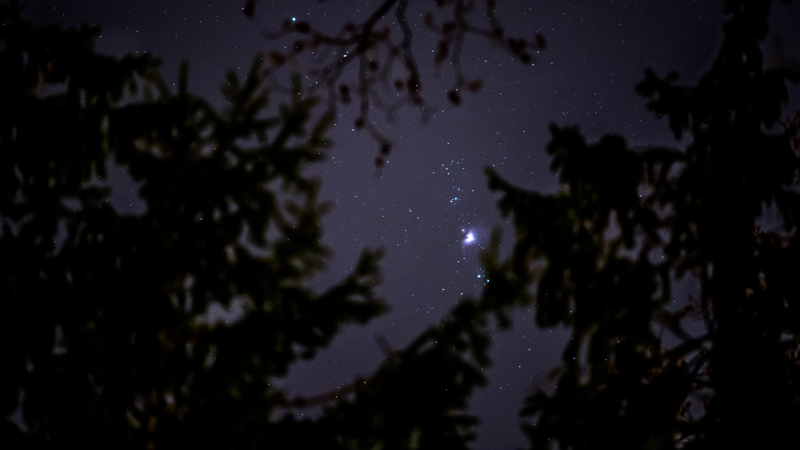From the Observer's Notebook — The Orion Nebula Through the Trees
January 21, 2018 A good place for a bird watcher, but a challenge for a serious stargazer.
A good place for a bird watcher, but a challenge for a serious stargazer.As back yards go, mine is a lot better for birdwatching than stargazing. With a dense canopy of mature trees, even with the branches picked clean of leaves in the winter months, I can stand in one place and count the number of bright stars I can see on one hand. If I want to haul out the telescope for a serious stargazing session, it means loading up the car and driving 90 minutes through rush-hour traffic to my local astronomy club site in northern Virginia. And I'm not always inclined to make that investment.
But on a recent winter night with superb clarity and not much energy for stargazing, I just couldn't turn away from the stars and head back inside to watch CNN. What to do? Turn a bug into a feature, of course, and work with what little sky I had.
I grabbed a pair of 12x36 IS binoculars and had a look through a few peep holes through the branches at some winter favorites. The Pleiades, the Hyades, the star fields of Perseus and Cassiopeia, and, of course, the Orion Nebula. To my surprise, the beauty of these famous sights was greatly enhanced by the foreground branches, especially the boughs of the tall pine trees that loom over the yard.
Why did the branches improve the view? I suppose it's because our brains appreciate foreground objects or scenes that put celestial objects in some sort of context. That's why nightscape images that combine foreground landscapes with vistas of the Milky Way are so compelling and dramatic, for example. Even the modern Christmas tree has its origins, so legend has it, from an evening in the 16th century when the otherwise dour Martin Luther was captivated by the sight of stars through the boughs of an evergreen tree.
 The Sword of Orion, including the Orion Nebula, through pine trees. Image taken with a Nikon D750, 70-200mm lens at 200mm, f/4, 2 second exposure at ISO6400. Processed in Adobe Lightroom.
The Sword of Orion, including the Orion Nebula, through pine trees. Image taken with a Nikon D750, 70-200mm lens at 200mm, f/4, 2 second exposure at ISO6400. Processed in Adobe Lightroom.The most beautiful of the vistas I glimpsed through network of branches was the Orion Nebula and the stars of the 'Sword of Orion'.In the binoculars, this nearest star factory to Earth and its attendant array of dazzling new blue-white stars was perfectly framed among a cluster of pine boughs. It was as pretty a sight as I'd ever seen.
So, of course, I had to try to capture it on camera. Not through binoculars, but with a telephoto lens that attempted to reproduce the scene.Without a means to guide the image (Polaris was completely blocked by the house) and with a lens of 200mm focal length, I was restricted to an exposure of only 2-3 seconds to avoid star trails. But modern DSLRs are mighty powerful, and with their big, low-noise sensors, I was able to crank up the ISO, open the lens wide, and grab an image with just a 2-second exposure that very roughly captured what I saw through the 12x36 binoculars. The view is always better visually of course, but the image worked out well enough for a quick snapshot. You can see the result above.
A quick binocular tour and a few snapshots through (and despite) the trees: a pleasant way to spend 20 minutes on a crisp, starry winter night- no traffic jams necessary. A good stargazer never lets a clear sky go to waste. Look up. You never know what you will see.
***
This article is © AstronomyConnect 2018. All rights reserved.
Please login or register to watch, comment, or like this article.jgroub likes this.
-
Final Announcement: We're Saying Goodbye to AstronomyConnect. Read Our Closing Notice.
Dismiss Notice
New Cookie Policy
On May 24, 2018, we published revised versions of our Terms and Rules and Cookie Policy. Your use of AstronomyConnect.com’s services is subject to these revised terms.

